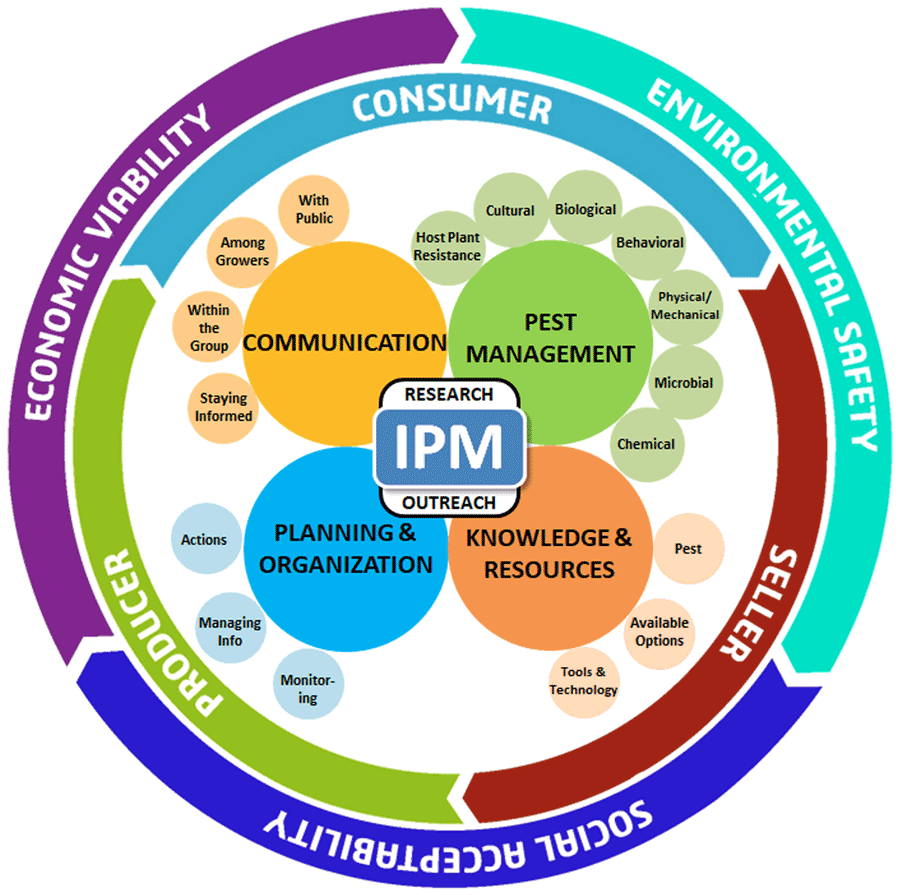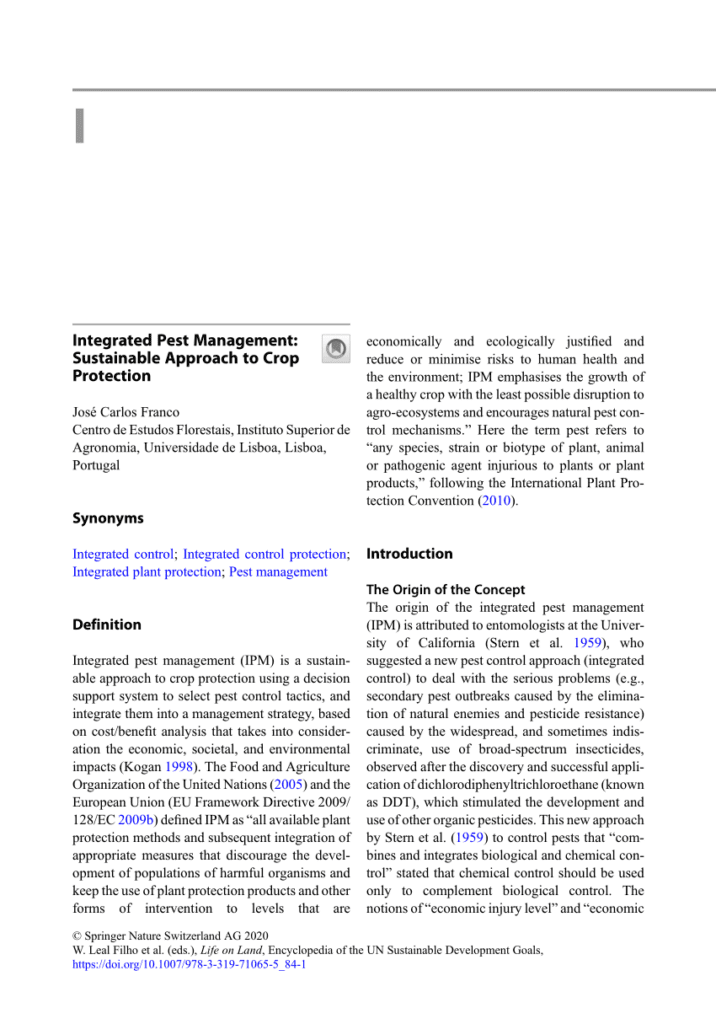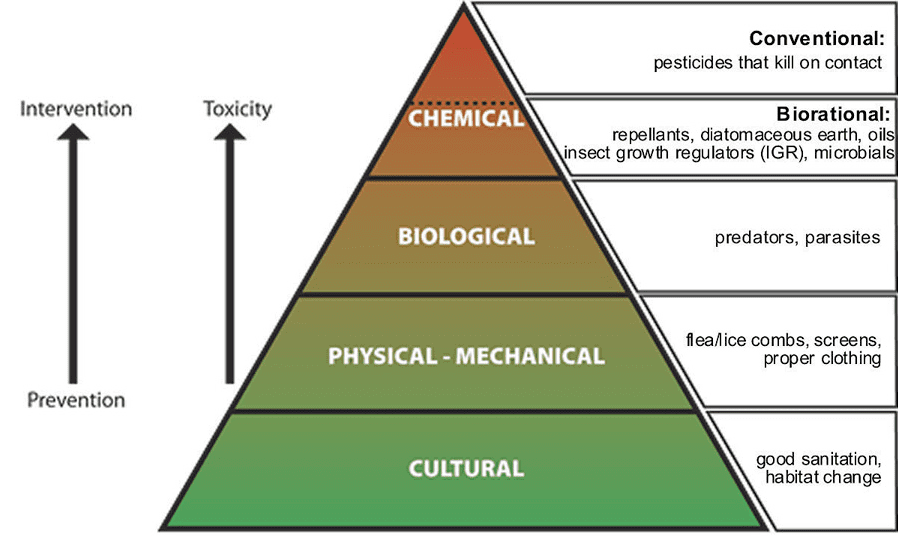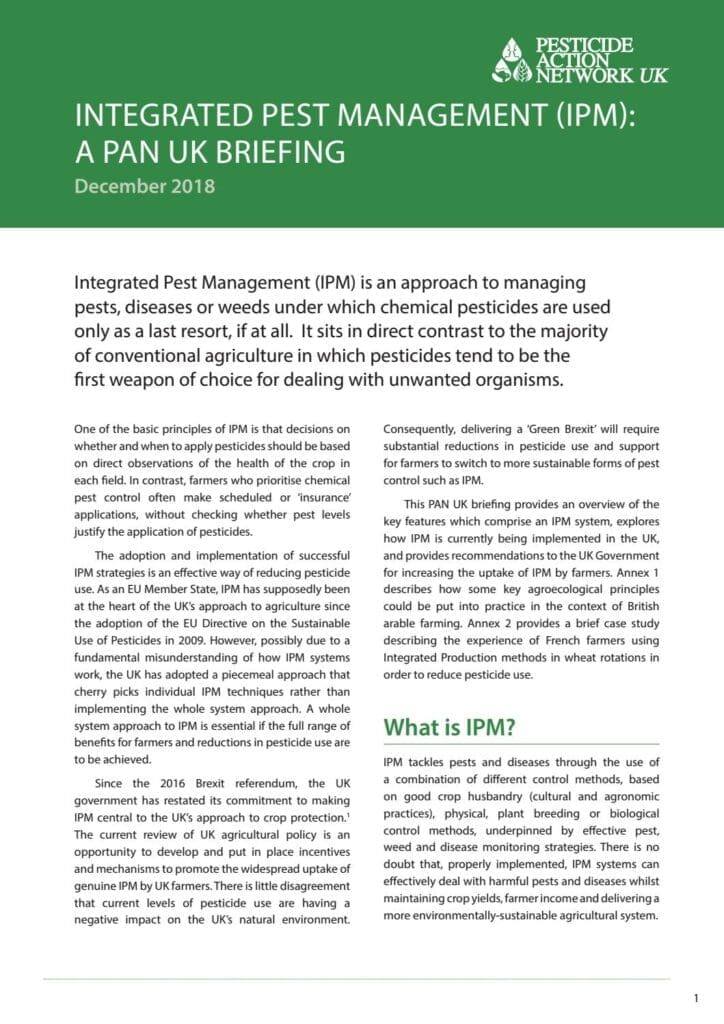In the world of pest control, Integrated Pest Management (IPM) has emerged as a sustainable approach that aims to address pest issues while minimizing harm to the environment and human health. With an emphasis on prevention, IPM focuses on utilizing a combination of biological, cultural, physical, and chemical control methods to manage pests effectively. By integrating various strategies tailored to specific pest problems, IPM offers a holistic and long-term solution that not only reduces the reliance on harmful pesticides but also promotes the overall health and balance of ecosystems. Discover the power of IPM and its potential to revolutionize pest control practices in this informative article.

What is Integrated Pest Management?
Definition of Integrated Pest Management
Integrated Pest Management (IPM) is a holistic and sustainable approach to pest control that aims to minimize the use of pesticides and prevent adverse impacts on the environment, human health, and economic resources. It involves the integration of various pest control methods to effectively manage pest populations, focusing on long-term prevention and monitoring.
Purpose of Integrated Pest Management
The primary purpose of Integrated Pest Management is to strike a balance between effectively controlling pests and minimizing harm to the ecosystem. This approach aims to promote sustainable pest control by reducing the reliance on chemical pesticides, preserving natural predators and beneficial insects, and optimizing the use of alternative pest control methods. By implementing IPM strategies, we can control pests while minimizing environmental damage and protecting human health.
Benefits of Integrated Pest Management
Economic Benefits
Implementing Integrated Pest Management can have significant economic benefits. By adopting a strategic and targeted approach to pest control, businesses and farmers can reduce the economic losses caused by pests. By effectively managing pest populations, crops can flourish, leading to higher yields and increased profitability. Additionally, IPM can reduce the reliance on chemical pesticides, which can be costly, thereby lowering the overall pest control expenses.
Environmental Benefits
One of the significant advantages of Integrated Pest Management is its positive impact on the environment. By minimizing the use of chemical pesticides, IPM helps prevent pollution of soil, water, and air. It also preserves natural habitats and ensures the survival of beneficial organisms such as pollinators and predators that play a crucial role in maintaining ecological balance. IPM contributes to the conservation of biodiversity and promotes sustainability in agriculture and pest control practices.
Health Benefits
Integrated Pest Management prioritizes the protection of human health by minimizing exposure to harmful chemicals. By reducing the reliance on chemical pesticides, IPM reduces the risks associated with pesticide exposure, including acute and chronic health effects. This approach also minimizes the residues of chemical pesticides in food, thereby enhancing food safety. By focusing on prevention and using less toxic control methods, IPM creates healthier living and working environments for both humans and animals.

Principles of Integrated Pest Management
Identification and Monitoring of Pests
The first step in Integrated Pest Management is to accurately identify and monitor pest populations. By understanding the pest species, their life cycles, and their behavior, pest control professionals can develop effective control strategies. Regular monitoring allows for early detection of pests, enabling timely intervention and preventing widespread infestations.
Prevention
Prevention is a key principle of Integrated Pest Management. By implementing preventive measures such as proper sanitation, exclusion techniques, and maintenance practices, pests can be discouraged from entering or establishing themselves in a particular area. Preventive measures aim to create an unfavorable environment for pests, minimizing their access to food, water, and shelter.
Control Measures
Integrated Pest Management utilizes a variety of control measures to manage pest populations effectively. These measures may include biological controls, cultural controls, physical controls, and chemical controls. The choice of control method depends on the pest species, the severity of the infestation, and the potential impact on human health and the environment.
Evaluation and Adjustment
Regular evaluation and adjustment are crucial in Integrated Pest Management. By monitoring the effectiveness of control measures, pest control professionals can assess their impact on pest populations and make necessary adjustments. This adaptive management approach ensures that control strategies remain effective and sustainable in the long term.
Understanding Pest Life Cycles and Behavior
Importance of Pest Life Cycles
Understanding pest life cycles is essential in Integrated Pest Management because it allows for effective timing of control measures. Pests undergo different stages of development, and targeting these stages can disrupt their life cycles and prevent reproduction. By interrupting a pest’s life cycle, their population can be reduced or eliminated, minimizing the need for additional control measures.
How Pest Behavior Affects Control Methods
Pest behavior plays a critical role in determining the most suitable control methods. Some pests may be attracted to certain pheromones, while others may be deterred by specific scents or tastes. By studying pest behavior, pest control professionals can implement control measures that exploit these preferences or aversions. For example, using traps or baits that mimic the pests’ natural food sources can effectively attract and eliminate them.

Use of Cultural and Physical Controls
Cultural Controls
Cultural controls involve modifying the environment or cultural practices to deter pests. These controls may include crop rotation, selecting pest-resistant plant varieties, providing optimal irrigation and fertilization, and practicing proper waste management. By creating unfavorable conditions for pests, cultural controls promote plant health and reduce pest vulnerabilities.
Physical Controls
Physical controls refer to the use of barriers, traps, or mechanical methods to physically exclude or eliminate pests. Examples of physical controls include installing screens, sealing cracks and crevices, using netting or fencing, and employing mechanical devices to trap or physically remove pests. Physical controls are often non-toxic and can be highly effective in preventing pests from accessing critical areas.
Biological Controls in Integrated Pest Management
Definition of Biological Controls
Biological controls involve the use of living organisms to control pest populations. These organisms may be predators, parasites, or pathogens that naturally keep pest populations in check. Biological controls aim to harness the natural predators and beneficial organisms present in the environment to limit the impact of pests.
Types of Biological Controls
There are several types of biological controls used in Integrated Pest Management. Predatory insects, such as ladybugs and lacewings, feed on pests, preventing their population growth. Parasitic wasps lay their eggs inside pests, ultimately killing them. Microbial pathogens, such as bacteria or fungi, can be used to target specific pests. Beneficial nematodes are also employed to control pests in soil.
Advantages and Limitations
Biological controls offer several advantages in Integrated Pest Management. They are often specific to the targeted pests, leaving beneficial organisms unharmed and reducing the risk of pesticide resistance. Additionally, biological controls can persist in the environment and provide long-lasting pest control. However, the effectiveness of biological controls can vary depending on environmental conditions, and they may require time to establish and achieve desired results.

Chemical Controls in Integrated Pest Management
Types of Chemical Controls
Chemical controls involve the use of pesticides to manage pest populations. However, in Integrated Pest Management, the use of chemical controls is minimized and carefully controlled. Selective pesticides that specifically target pests while sparing non-target organisms are preferred. Chemical controls are typically used as a last resort and in combination with other pest control strategies to reduce their overall usage and potential environmental impact.
Importance of Responsible Chemical Use
While chemical controls are a part of Integrated Pest Management, responsible chemical use is crucial to prevent adverse effects on the environment and human health. It involves using pesticides according to label instructions, employing proper application techniques, adhering to safety protocols, and minimizing pesticide residues. By employing responsible chemical use practices, the potential risks associated with pesticide use can be significantly reduced.
Technological Advances in Integrated Pest Management
Advancements in Pest Monitoring
Technological advancements have greatly improved pest monitoring in Integrated Pest Management. Remote sensing technologies, drones, and image recognition software can detect and monitor pest populations on a large scale. Automated pest monitoring systems can track pest activity, allowing for early detection and timely intervention. These advances in pest monitoring enable pest control professionals to respond quickly and effectively to potential infestations.
Smart Pest Control Devices
Smart pest control devices are becoming increasingly popular in Integrated Pest Management. These devices utilize sensors, artificial intelligence, and data analysis to monitor and control pest populations. For example, smart traps can detect pests, collect data on their behavior, and notify users when action is required. These devices enhance the efficiency of pest control by providing real-time data and enabling targeted interventions.

Implementing Integrated Pest Management
Assessing the Pest Problem
The first step in implementing Integrated Pest Management is to assess the pest problem thoroughly. This involves identifying the pest species, determining the extent of the infestation, and evaluating the potential risks. Assessing the pest problem provides valuable information for developing an effective and tailored pest control plan.
Creating a Plan
Based on the assessment of the pest problem, a comprehensive pest control plan is developed. The plan outlines the specific control measures to be implemented, considering the principles of Integrated Pest Management. It includes strategies for prevention, monitoring, and control, ensuring a systematic and sustainable approach to pest management.
Applying Control Methods
Once the pest control plan is established, the identified control methods are implemented. This may involve a combination of cultural controls, physical controls, biological controls, and, if necessary, carefully selected chemical controls. The application of control methods should be targeted, effective, and in accordance with local regulations and safety guidelines.
Monitoring and Evaluation
Monitoring and evaluation are crucial components of Integrated Pest Management. Regular monitoring ensures that control methods are effective and timely adjustments can be made if needed. Evaluation involves assessing the outcomes of control measures and determining their impact on pest populations. By continuously monitoring and evaluating, pest control professionals can refine their strategies and improve overall pest management efforts.
Evaluating the Effectiveness of Integrated Pest Management
Measuring Success
Measuring the success of Integrated Pest Management is essential to determine the effectiveness of control measures. Success can be measured by assessing factors such as the reduction in pest populations, the prevention of damage to crops or structures, and the decrease in pesticide use. Economic indicators, such as cost savings or increased yields, can also be used to measure the success of IPM implementation.
Identifying Areas for Improvement
Through the evaluation process, areas for improvement in Integrated Pest Management can be identified. This may include fine-tuning control strategies, addressing any gaps in pest monitoring or prevention, or exploring new techniques or technologies. Identifying areas for improvement ensures that Integrated Pest Management practices continue to evolve and adapt to changing pest control needs and environmental factors.
In conclusion, Integrated Pest Management offers a sustainable and holistic approach to pest control. By incorporating various control methods, understanding pest life cycles and behavior, utilizing cultural and physical controls, employing biological and responsible chemical controls, harnessing technological advancements, and implementing a structured plan, Integrated Pest Management ensures effective pest control while minimizing environmental harm and promoting long-term sustainability.

I am Randy, the author behind PestControld.com. Drawing from decades of experience, I aim to provide valuable insights, expert advice, and practical recommendations to help you make informed decisions when assessing viable pest control solutions.